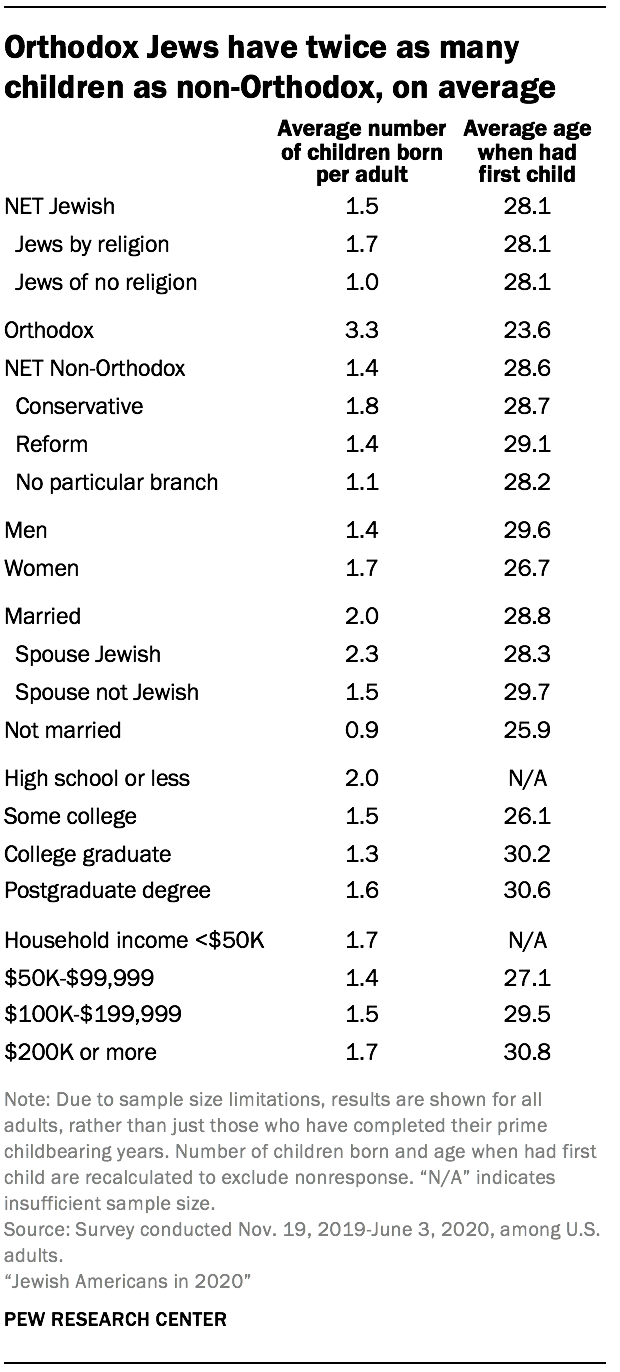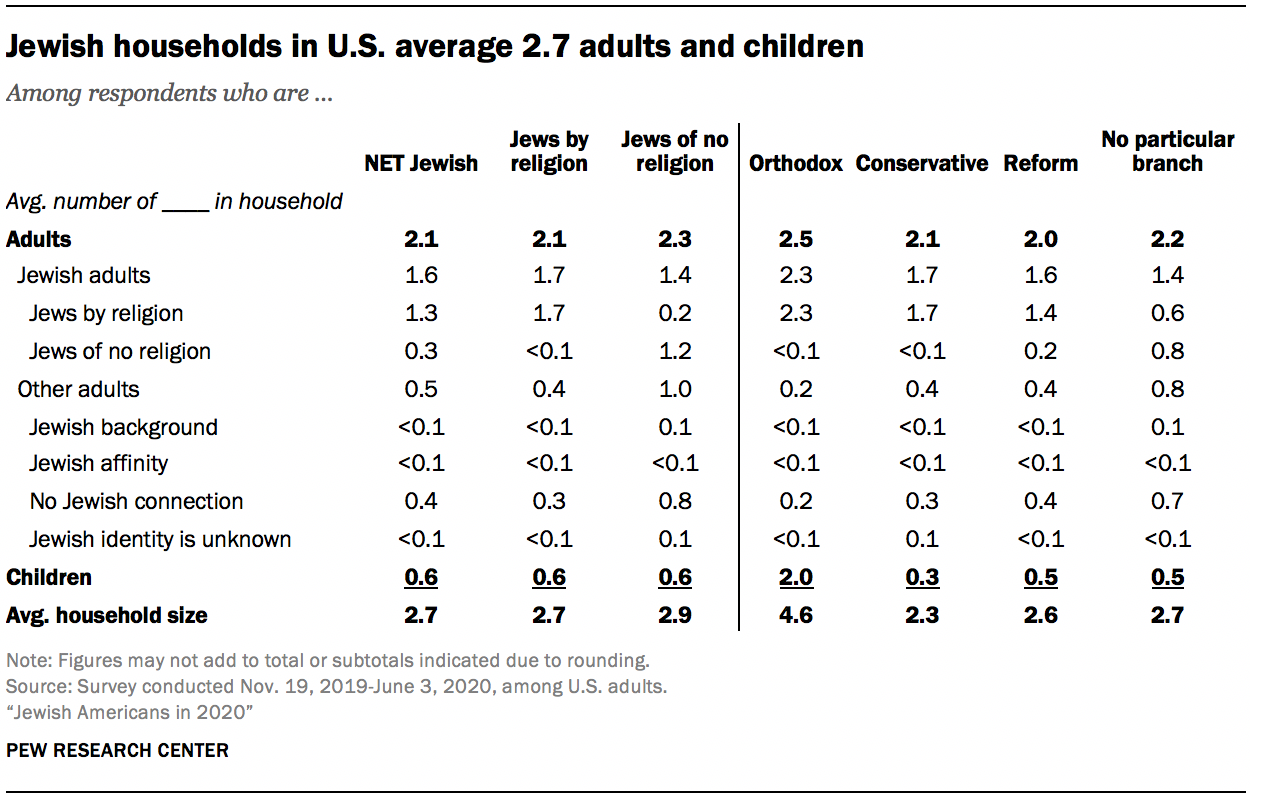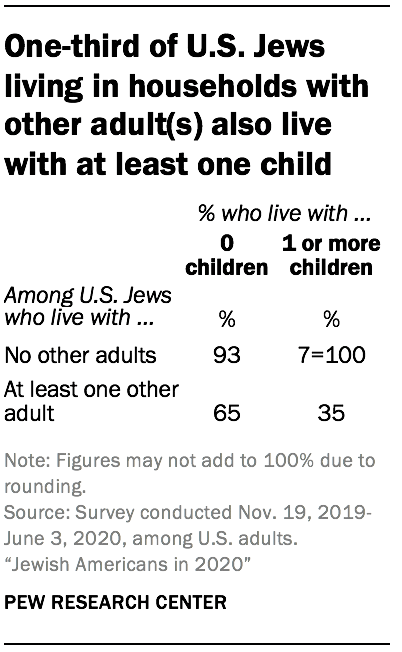The demographic profile of Jewish Americans is distinctive in several ways. Compared with the overall public, the Jewish population is older, has relatively high levels of educational attainment and is geographically concentrated in the Northeast.
Jewish adults ages 40 to 59 also have slightly fewer children, on average, compared with the general public. However, Orthodox Jews have much higher fertility rates and live in larger households than non-Orthodox Jews.41
The remainder of this chapter provides further detail on the demographic characteristics (including fertility rates and household sizes) of Jewish Americans. It also looks at the self-described sexual orientation of U.S. Jews.
Fertility
 In the 2020 survey, Jewish adults ages 40 to 59 report having had an average of 1.9 children, the same as in the 2013 survey and slightly below the comparable figure for the general U.S. public, which is 2.3 children per adult in the same age cohort.42 While some adults in this age range may continue to bear children, this statistic is a rough measure of the completed fertility of this cohort.
In the 2020 survey, Jewish adults ages 40 to 59 report having had an average of 1.9 children, the same as in the 2013 survey and slightly below the comparable figure for the general U.S. public, which is 2.3 children per adult in the same age cohort.42 While some adults in this age range may continue to bear children, this statistic is a rough measure of the completed fertility of this cohort.
However, to increase the reliability of comparisons across subgroups of Jews, this study also uses information from all adults in the survey. This includes young adults in their prime childbearing years (who may give birth to additional children in the future) as well as older adults (who may already have had all the children they intend to bear).
Based on reports from adults of all ages, the survey finds that, on average, Jews by religion have more children than Jews of no religion (1.7 vs. 1.0), and Jews with spouses who are also Jewish have more offspring than religiously intermarried Jews (2.3 vs. 1.5).
The survey also indicates that fertility among Orthodox Jews is at least twice as high as among non-Orthodox Jews. Orthodox Jewish adults report having an average of 3.3 children, while non-Orthodox Jews have an average of 1.4 children. Orthodox Jews also are five years younger, on average, when they give birth to their first child (23.6 vs. 28.6 among non-Orthodox Jews).
Fertility differences between Jews and the general public are driven in part by the greater share of Jewish women who have never had children. Among women ages 40 to 59, Jews are twice as likely to have no children (20% vs. 10%).

Household size and composition
The average U.S. Jew lives in a household of 2.7 people, including 2.1 adults and 0.6 children. Overall, the average size of Jewish households has not changed much since the 2013 survey.
 Orthodox Jews tend to live in much larger households than Jews who identify with other branches or streams of American Judaism. The average Orthodox household in the survey contains 2.0 children, compared with 0.3 children per household among Conservative Jews and 0.5 children per household among Reform Jews.
Orthodox Jews tend to live in much larger households than Jews who identify with other branches or streams of American Judaism. The average Orthodox household in the survey contains 2.0 children, compared with 0.3 children per household among Conservative Jews and 0.5 children per household among Reform Jews.
As of 2020, about one-third of Jewish adults who live with at least one other adult (who could be, but is not necessarily, a spouse or partner) have children living in the household. It is much less common for Jews who are the sole adult in their household to have children living with them.
Age
 The survey finds that, on average, Jewish adults are older than the U.S. public as a whole. But a closer look reveals that this is true only for Jews by religion. Jews of no religion, on average, are younger than U.S. adults overall.
The survey finds that, on average, Jewish adults are older than the U.S. public as a whole. But a closer look reveals that this is true only for Jews by religion. Jews of no religion, on average, are younger than U.S. adults overall.
Among adults, the median age in the Jewish population is 49 – slightly older than the median age of adults in the general public (46). Jews by religion (adult median age of 54) are similar in age to U.S. Protestants (53), and Jews of no religion (median age of 38) are similar in age to religiously unaffiliated people in the broader U.S. population (39).
Looked at another way, roughly half of Jewish adults are ages 50 and older (49%), compared with 45% of adults in the general public. Among Jews by religion, 56% are 50 and older, compared with just 32% of Jews of no religion.
Orthodox Jews (median age of 35 among adults) are substantially younger than Conservative Jews (62) and Reform Jews (53).
 Education
Education
U.S. Jewish adults are, on the whole, a comparatively well-educated group. Nearly six-in-ten are college graduates, including 28% who have obtained a postgraduate degree. By comparison, among U.S. adults overall, about three-in-ten are college graduates, including 11% who have a postgraduate degree. Both Jews by religion and Jews of no religion have much higher levels of educational attainment, on average, than does the public overall.
About two-thirds of Reform Jews (64%) say they are college graduates, as do 57% of Jews with no denominational affiliation and 55% of Conservative Jews. Fewer Orthodox Jews (37%) report having college degrees.
Sexual orientation among U.S. Jews
The survey finds that 4% of U.S. Jews identify as gay or lesbian, and an additional 5% say they are bisexual. About nine-in-ten U.S. Jews (88%) say they are straight. Compared with Jews by religion, somewhat fewer Jews of no religion say they think of themselves as straight (81% vs. 91%). Instead, Jews of no religion are more likely than Jews by religion to say they are bisexual (10% vs. 3%).
Older Jews are more likely than younger Jews to say they are straight. Fully 96% of Jewish adults ages 65 and older say they are straight, as do 93% of those between the ages of 50 and 64. Fewer Jewish adults in their 30s and 40s (85%) and under 30 (75%) identify as straight.
The percentage of Jewish adults who identify as straight (88%) is similar to the share of the overall U.S. public that identifies that way (89%). And the share of Jewish adults under 30 who describe themselves as straight is on par with the share of U.S. adults under the age of 30 who say the same (78%).
This question asked about U.S. Jews’ sexual orientation; it did not measure transgender identity.

Geographic distribution
 About four-in-ten Jewish adults (38%) live in the Northeast – roughly double the share of U.S. adults overall who live in that census region (18%). A quarter of Jewish Americans reside in the West (25%), and a similar share live in the South (27%). Just one-in-ten Jewish adults live in the Midwest.43
About four-in-ten Jewish adults (38%) live in the Northeast – roughly double the share of U.S. adults overall who live in that census region (18%). A quarter of Jewish Americans reside in the West (25%), and a similar share live in the South (27%). Just one-in-ten Jewish adults live in the Midwest.43
Compared with Jews by religion, Jews of no religion are somewhat more evenly distributed across the Northeast, South and West.


